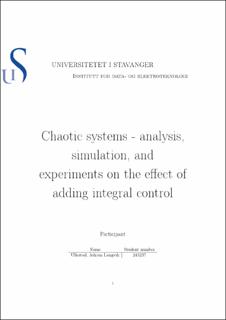| dc.contributor.advisor | Thorsen, Kristian | |
| dc.contributor.author | Ullestad, Adrian Langvik | |
| dc.date.accessioned | 2022-11-17T16:51:33Z | |
| dc.date.available | 2022-11-17T16:51:33Z | |
| dc.date.issued | 2022 | |
| dc.identifier | no.uis:inspera:92612183:22538391 | |
| dc.identifier.uri | https://hdl.handle.net/11250/3032547 | |
| dc.description.abstract | Model chaotic systems into Matlab/Simulink, or other programs that allow
simulations. The systems should then be simulated for different disturbances
to observer both the step response and how the amplitude, average value
of amplitude and frequency, for one or more output variables, changes for
different disturbance values. The results can be presented both as a time
response or in bifurcation diagrams. Then the systems should be expanded
to allow one or more I-controller and perform the same analysis again, to see
the effect the I-controlled has on the system. Then if given the time create
one of the systems as an electrical circuit.
The models are created in Matlab using the ode45 solver on a Matlab
script, made from the differential equations, for each of the chaotic models
used. To create the Simulink model we simply started implementing the differential
equations into Simulink. The next part is the expanded Simulink
model with an I-controller, which was made possible by adding the integral
response into the differential equation for x. Then adding an closed-feedback
loop from x to calculate the error. To perform the simulation of the expanded
chaotic systems we needed to find the integral gain, Ki, which was
done by finding the transfer function from u, integral response, to x, the
output. After finding the transfer function we made some assumptions, and
then by comparing the closed-loop function, M(s), with a desired closed-loop
function, Md(s), we can calculate the integral gain, Ki.
From the simulations done on simple chaotic systems we can say that
there is not a big difference to the results we get from a simulation of the
Matlab script and on a model made in Simulink. Taking a look at the results
from the calculations for Ki and the simulations using this value gave us
some satisfying results for most of the chaotic systems. | |
| dc.description.abstract | Model chaotic systems into Matlab/Simulink, or other programs that allow
simulations. The systems should then be simulated for different disturbances
to observer both the step response and how the amplitude, average value
of amplitude and frequency, for one or more output variables, changes for
different disturbance values. The results can be presented both as a time
response or in bifurcation diagrams. Then the systems should be expanded
to allow one or more I-controller and perform the same analysis again, to see
the effect the I-controlled has on the system. Then if given the time create
one of the systems as an electrical circuit.
The models are created in Matlab using the ode45 solver on a Matlab
script, made from the differential equations, for each of the chaotic models
used. To create the Simulink model we simply started implementing the differential
equations into Simulink. The next part is the expanded Simulink
model with an I-controller, which was made possible by adding the integral
response into the differential equation for x. Then adding an closed-feedback
loop from x to calculate the error. To perform the simulation of the expanded
chaotic systems we needed to find the integral gain, Ki, which was
done by finding the transfer function from u, integral response, to x, the
output. After finding the transfer function we made some assumptions, and
then by comparing the closed-loop function, M(s), with a desired closed-loop
function, Md(s), we can calculate the integral gain, Ki.
From the simulations done on simple chaotic systems we can say that
there is not a big difference to the results we get from a simulation of the
Matlab script and on a model made in Simulink. Taking a look at the results
from the calculations for Ki and the simulations using this value gave us
some satisfying results for most of the chaotic systems. | |
| dc.language | eng | |
| dc.publisher | uis | |
| dc.title | Kaotiske systemer - analyse, simulering og eksperimenter på effekten av å legge til en integral regulator | |
| dc.type | Master thesis | |
